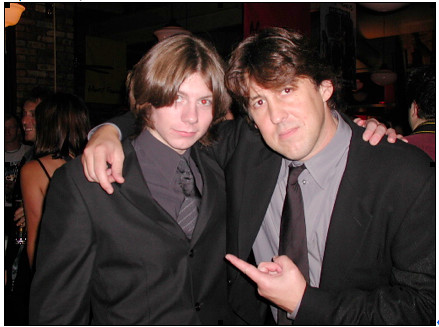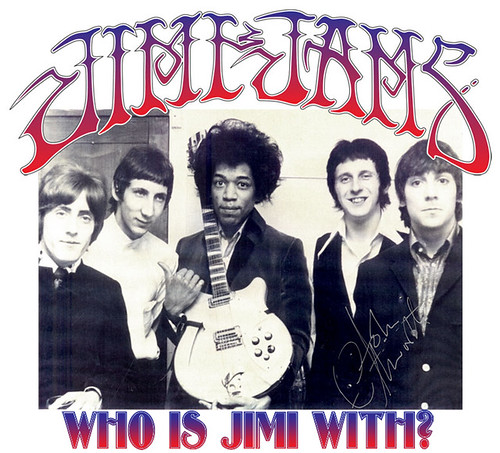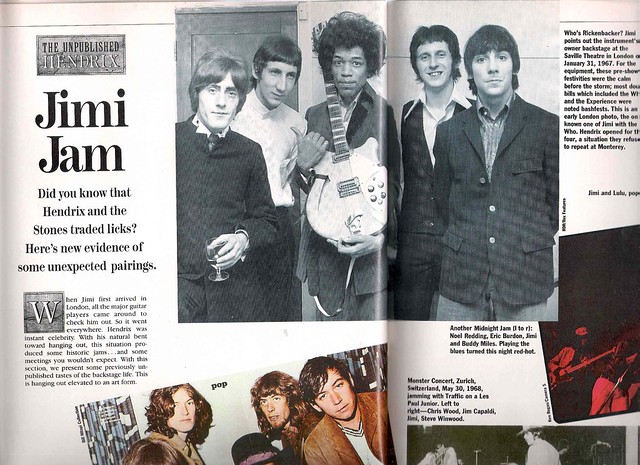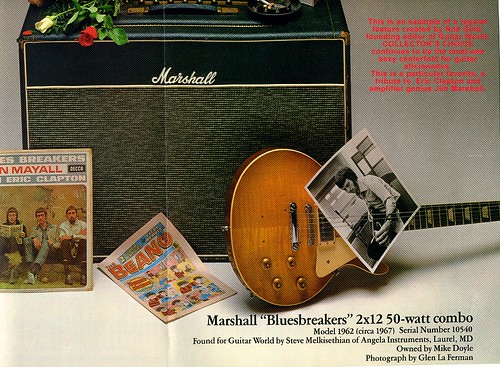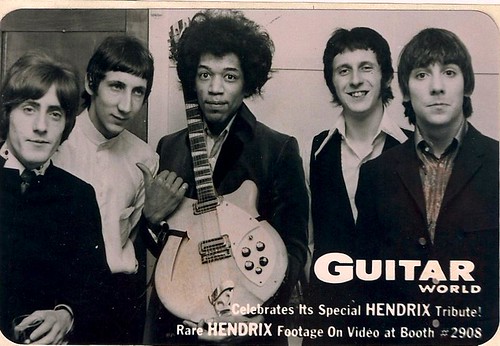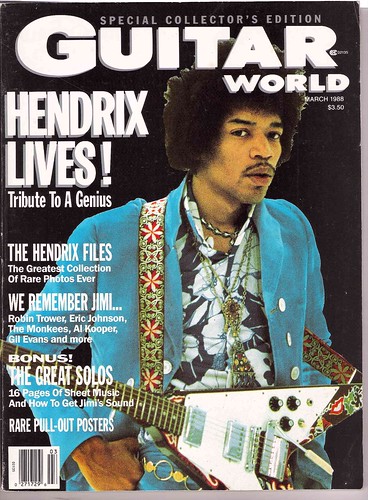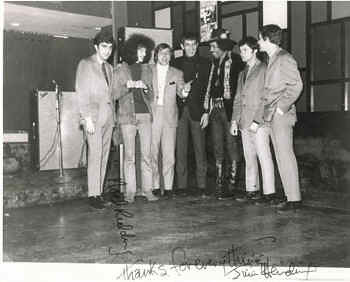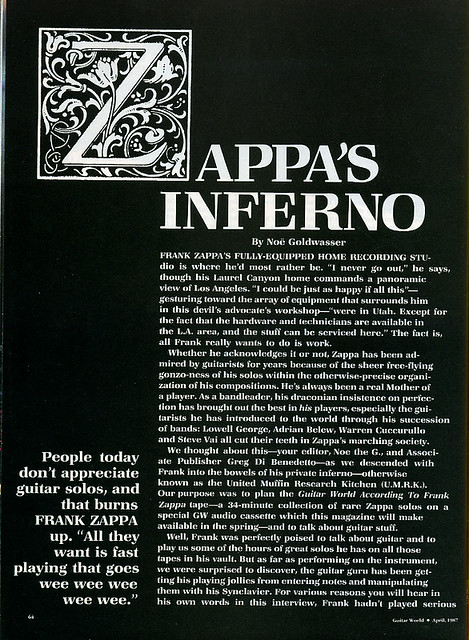
Well, Frank was perfectly poised to talk about guitar and to play us some of the hours of great solos he has on all those tapes in his vault. But as far as performing on the instrument, we were surprised to discover, the guitar guru has been getting his playing jollies from entering notes and manipulating them with his Synclavier. For various reasons you will hear in his own words in this interview, Frank hadn't played serious guitar in two years (the last recorded example of Frank playing will be available on our Guitar World According To Frank Zappa tape). He'd even lost his callouses!
But fear not, dear reader. Zappa had plenty to say about playing guitar and where the instrument is going. And, believe us, there's reams of guitar in Frank's vaults, which he continues to classify and release to the public as long as the demand is there, through his own Barking Pumpkin organization. The Shut Up And Play Yer Guitar collections did quite well worldwide, so you can expect more to be released in the future.
And we hear that since our talk with Frank, he's been building up his callouses and thinking about going back on the road with his guitar and a band. The moral: you can take the Zappa out of guitar playing, but it'll take a long time to get all the guitar playing out of Frank Zappa.
Let me get a level on the tape recorder. Say, "The poodle bites."
Frank Zappa: The poodle chews it.
Come on, Frenchie! Do you see a conceptual continuum between, say, "Call Any Vegetable" and Shut Up And Play Yer Guitar? Or between the Mothers 0f Invention and the Mothers of Prevention?
There are some links, yeah. The main drawback of the medium I'm working in is, until I got the computer I was locked into making music based on the assets and/or liabilities of the guys in the band. In other words, if you want to write something that's faster than what the guys can play, you can't hear it, because they can't play it that fast. Or if you want something for an instrumentation that you don't have in the band, then you won't hear it. But now that I can do it with a computer, that's not a problem anymore.
Was it always that way? When you were writing parts for, say Roy Estrada, or anybody in the early days for instance, it was all charted out, and-
N0--because, the only time I ever had a band where everybody could read [music] was the band that had Jean-Luc Ponty and Ralph Humphrey, and Ian and Ruth [Underwood] and George [Duke], that was a reading band. And Grand Wazoo, that was a reading band. All the rest of 'em were like half-and-half. Half the guys could read, half of 'em couldn't.
Now with the computer--the Synclavier-- you don't need the band to work out the music. What about the quality of the sound itself?
I'll play you some tapes; you tell me.
What about MIDI? Some say it's the next big thing. Others say, "it's not a guitar anymore."
It's either guitar plus or guitar minus, depending on how you look at it. The big problem with doing anything MIDI is the lag. It's like learning how to play a church pipe organ. Because when you press a key on a pipe organ, the sound doesn't come out right away. It's the same thing with MIDI. You have to get used to the lag. I can't. I haven't played a guitar synthesizer yet that feels comfortable.
With the Synclavier, can you explain that? The mechanical differences in working with that.
What? for the way I compose on it? I can enter information with the octapad, and I can enter it with the keyboard, or I can type it in.
Can you spontaneously jam with it?
Yeah. You can take a completely improvised line and build an entire composition out of it.
You see, it's still a single line. But with this, you can improvise a single line and have that line being played by a whole ensemble of instruments and actually have those instruments play that line in harmony. It's not an improvised line anymore. It's an arrangement.
What is all that activity doing to your guitar playing per se---
Haven't touched it in two years.
[There is a brief pause as the interviewers collect what's left of their minds from the floor.]
You haven't?
[Zappa sits back in his chair, letting this one sink in.]
You don't miss it at all?
Every once in a while... but I don't play a style that is contemporary, you know? I don't do all the 1980s guitar noises. Unfortunately, the audience for guitar playing has a real narrow interest span. If you don't sound like Eddie Van Halen, then apparently you don't actually play guitar any more. I have no intention of ever sounding like Eddie Van Halen, and, uh, it makes you wonder why you would even bother to play the guitar, because the current audience would listen to it and go, "That's not a guitar. It doesn't go 'wee wee wee wee, wee wee wee wee.'" So why do it?
Dweezil would probably rebut that, what with his own infatuation for Ed Van Halen.
I'm not saying anything against Eddie because I think what he's done for the guitar is wonderful. But the thing that's tragic
about the marketplace is that everybody decided that they were all going to do that, and then the competition is not musical. It's gymnastic. Okay, they say, "I want to sound like Eddie, but in order to be better than Eddie I have to be faster than Eddie." That seems to be the aesthetic operating procedure in the marketplace. Meanwhile, Edward probably sits back and goes, "These guys are really stupid." Because I don't think that's what he had in mind when he developed the style.
It's just like with MTV. MTV has a certain look, because it has a limited pictorial vocabulary. All the videos are made up of certain icons. If you don't work in that vocabulary, then the MTV audience doesn't perceive it as a real video, know what I mean? It's gotta have certain things in it. So, take your pick. You can write hooks and go in there and do that shit, or you can do something else. I decided to do something else.
I'm looking for whatever else is out there. I'm looking for different structures, different sounds, different types of harmonic combinations. Different rhythms.
The guitar ... aside from being busy with other stuff, the reason you put it down two years ago or whatever ... does it not give you that anymore? Because I personally--and a lot of our readers--love your guitar sound. To me that always meant your personal voice within whatever music we were hearing. If you had the band going precision and precise ... but when you hit the guitar solo, it was not precise at all. It was something transcendent, something out.
It's another vegetable. The problem is, most of the best stuff that I will physically be able to do on the guitar is already on tape. You just haven't heard it yet. I mean, I don't have much incentive to play it. I don't have any callouses anymore. I can still think guitar. But to physically manipulate it, I would have to go back in and woodshed for months on end just to be able to do it. For what? There's really no audience for it. Which is not to say that there's a great audience for this new digital stuff either, but I have more incentive to work on this, because it leads to other more interesting things than to sit in there and practice the guitar. Because even when I was playing the guitar I didn't practice. You know? When I was on the road I would do an hour a day before the show, but, I've never been one of those guys ... Dweezil practices non-stop, day in, day out.
So the guitar solo right now, doesn't really play a role in your music? Even for things that can't be done with the Synclavier?
Well, look at it this way: I got plenty of tapes of these things. I can release another guitar solo album. And, when you see what the guitar solo has been reduced to in contemporary music, it's like an eight-bar fill. And during that fill, you're supposed to play every hammer-on lick that you know as fast as you can play it, followed by 15 feedback noises and then get the fuck out of there. You know, that's what the guitar solo has been reduced to, and that's not the medium I've ever worked in.
I recall you saying once that the hardest thing to accomplish in a guitar solo is to come up with a distinct melody within that solo. The solo itself would be ... improvised.
Yeah, just make it up on the spot--
But a melody--
--Yeah, well listen to what's going on in solos today. When was the last time you heard someone make one up with a melody?
When you're composing, and you're working with the Synclavier, and you get to a point where in the old days you were thinking about composing for the guitar as well, what do you do at that juncture? Do you put a coda-type thing in there?
It would be difficult to talk about what I'm doing over there since you don't know what it is. I should just stop the tape and go over there and show you what I'm doing.
[Stops tape and we get a demo of Frank composing on the Synclavier He taps out a few seemingly random rhythms, makes some observations of the CRT screen and manipulates parameters of music around the "random rhythms." The music coming out of the Synclavier is many-faceted, but typical Zappa, with percussive marimbaesque runs and odd cat growls prancing about together.]
That sounds like your music. Same guy.
Are you familiar with the piece on the Shut Up And Play Yer Guitar album called "While You Were Out?" Well, on the new album [Jazz From Hell] there's a deluxe computer version of that. But it's not played by a guitar.
I look at that thing-the recording console-and it's like a musical instrument, if you use it the right way. You've gotta start with a musical idea. if it's not a musical idea what is it? An equation?
How do you get that? How do you start? Do you have entire complicated things full-blown that spring out of your brain, or do you start with something small and you build it up?
Sometimes, I have a complete vision of what the thing is and it's just drudgery to go in there and execute the vision. And another way is, you start by hitting a couple of notes on that [Synclavier], and if you like it you save 'em and make a piece on it, and if you don't you throw it away.
How do you keep track of everything? On each floppy, there's like a million things...
Aaah! then you have to have a good memory.
Yet, when we first started talking about this interview, we discussed guitar noisemakers and these devices that you seem to have a fondness for--the Green Ringers and the Uni-Vibes and such. Things that give that idiosyncratic, anarchic tone.
Well, I like the sound of a guitar. My idea of the best use of a guitar is some thing that's personal ... not necessarily commercially viable. There are things I like to hear coming out of a guitar. But that's my personal taste.
The Shut Up And Play Yer Guitar series, how did the three records do commercially?
Real good, as a matter of fact. And it surprised the shit out of a lot of people. For example, when it was first released, there
were 30,000 units of that three-record box sold in France alone. Which is some thing of a merchandising miracle in that country. It's done well and it's still selling.
So, are you going to do any more of those?
Yeah, I got another one that I've been fooling around with.
And that's all stuff, like what you said before, "I don't have to play guitar because I have so much stuff already" and it's--
--it's on tape, right.
Do you have any urge to play at all in public any more?
I'd have to have an awful good reason, and in order to play in public I'd have to learn to how to play the guitar again--literally. I don't have any callouses. I couldn't bend the strings.
It's weird because we're from a guitar magazine and you're not really into playing guitar anymore.
Well, what's that got to do with releasing guitar records? As I told you, there's plenty of stuff on tape. I can play you some stuff--examples of what's lurking in the archives. I've even sequenced a few of the solos, but I haven't come up with a satisfactory sequence for about six sides of guitar stuff ... there's just masses to choose from [Solos Frank is talking about will be available as The Guitar World According To Frank Zappa in a future issue of this magazine. Watch for it--GW Ed.]
How were these recorded?
All live.
They are live. So how do you deal with the 24-track?
They're all different. Some of them were recorded four-track live, but that doesn't mean they sound cheesy. One thing I always hated to do was play guitar in a studio. I always thought it was an incredibly boring experience.
Like playing in a vacuum, isn't it? So therefore, in order to really play guitar, you've got to hire a band, and that becomes cumbersome. And I guess nobody's going to want to audition just to be in Frank's back-up band, just so Frank can play guitar. If it's not necessarily going to go on a record or something.
That's true. It's the law of supply and demand, you know? There ya go.
But with all this involvement, do you still keep up with who the musicians are around here?
No. I mean, the guys who were good yesterday are still good today-unless they've nuked themselves with drugs. The guys that are going to be good, we'll eventually hear about 'em anyway.
Do you still hear from some of the guys you've played with? Does Steve Vai, for instance, keep in touch with you?
Yeah, he comes over every once in a while. But he was on the road for a year.
How did you first meet up with him?
He sent me a cassette. When he was 17.
And he was in a music school at the time.
Berklee.
How about Adrian Belew?
I found Adrian working in a bar in Memphis, Tennessee. He was working in a bar band. They were all dressed like the Godfather. They had, you know, fake mob-type suits on and stuff and he was doing Roy Orbison imitations.
I never would have thought of him like that. Did you hire him on the spot?
No. I don't hire people right away. I give them a chance to audition.
Was he always into that Hendrix thing, or did he develop it later?
He was doing some of it at that show.
Can you give our readers any practical advice?
Give me a field. Help them with what? Getting a job? How's this?: You want to get a job? Practice all your licks real fast. Get a good wardrobe. Get a good barber. Want to get a record contract? Get a good wardrobe, get a good barber. Don't even worry about how you play. They're not signing musicians anymore, they're signing models. Make sure you look good.
Look, everybody who buys a record has a right to buy what they like. And obviously, somebody really enjoys what's being produced today, or they wouldn't buy it. However, I think there's more to music than what is being made available by the record companies because they have been completely bamboozled by the video music syndrome. Record companies have made a major mistake. MTV came along and they thought, "Oh! this is it. We're no longer going to make records"--those little plastic things that people listen to?--"What we're going to do, we're going to sign groups that look like models, so that they can have a video on MTV."
The down side of this is the record companies are now totally at the mercy of MTV--that's their main outlet. How many videos can they show on MTV? Not that many. This limits the opportunity for people who actually play music. To play music, because you're not going on MTV unless you belong on MTV; furthermore, you're probably not going to get a record contract unless the guy at the record company thinks you look good.
Now, not all musicians are beautiful people. In fact a lot of 'em would generally qualify as being physically unattractive. But so what? If you like a record, you can listen to that record a hundred times and still get off on it. If you like a video, how many times can you watch it? Six, ten? Thirty, if you're a vegetable. And then it's old.
So the record industry has kind of chosen this one path and I think they made a mistake. Thev have igoored the desires of that segment of the audience that likes to listen to music. They like to hear it. It goes in through your ears. Video music is another thing. It goes in through your eyes. And better than 50 percent of what you experience is visual. The music is secondary to the pictures. So, if musicians who are just beginning think only of how much money they're going to make and whether or not they're going to have that big video career ... they have to decide right now whether or not they want to play music or be a model. And if it's the bucks they're after, like I said, "Get yourself a good wardrobe. Get a good barber. Don't worry too much about what you're going to play," because the chances are, if your publicity picture really looks good, the guy at the record company won't even listen to your tape. If you got the look, they'll find a producer to make you sound like something, because all you're ever going to do is lip-sync it anyway. Okay? You're never really gonna have to play it live. Chances are some producer hired by the company will come in and do what you're supposed to be able to do. And if that sounds like science fiction, I bet there's plenty of people right now, readin' the magazine saying, "Yeah, that's what I want to do!" And they should do it. Because there's somebody who wants to buy that. But that's not music as far as I'm concerned.
Did you give Dweezil that advice before he put his lp out? Apparently, it's worked, because he's gotten on MTV. And he looks good, so----
--well, I can't help the way he looks. And he chooses his own wardrobe, but the fact of the matter is that Dweezil can actually play an instrument.
So that's a fluke, according to your theory of how musicians make it these days.
Yeah, yeah. Uh, he's a mutation.
No more school for him, right?
He was out of school at 15 because in California you can take the high school equivalency test at 15 and get a diploma. So he's out. Moon did the same thing.
So he's not going to college, or ...
Why should he? He doesn't want to be a dentist, he doesn't want to be a lawyer. He wants to be a guitar player.
Are you aware of people like Yngwie Malmsteen?
I know who he is. Dweezil played me a tape of his.
What do you think of him?
Uh, not my style. Good ...
Does Dweezil look up to him? Is he influenced by him?
I think everybody who does gymnastic guitar and looks at other gymnastic guitarists sort of goes, "How fast is he movin' his fingers?" It is a competitive thing. But you have to ask him about that.
Yngwie himself might be an original, but if everybody's copying him, that shows you how bankrupt people are.
Yeah, but come on; in the seventies everybody was going as fast as John McLaughiin. As long as the media celebrates the guy who is the fastest, that's what people are going to go for.
I think it is wonderful to be able to play fast. It's even more wonderful to play things that are impossible. It's even more wonderful to defeat the law of averages. Things that you play fast are usually things that you rehearse fast. I'll tell ya a fast guitar player--Tommy Tedesco. You want to hear somebody play some scales? Go hear Tommy. Tommy can play other stuff, too.
You've talked about your antecedents, like Johnny Guitar Watson and others you were influenced by. There's no obvious trace of them. It must be less literal.
What I've taken from them is not from their sound it's their attitude. I'm probably stylistically closer to Guitar Slim than anybody else. But since nobody knows what he did ...[laughter]. There's a couple of solos he played that I thought were landmarks--but they were very obscure.
Watson, he's the original minimalist guitar player. The solo on "Lonely Nights," the one-note guitar solo? Says it all! Gets the point across. I can remember guitar players in high school learning that solo and just going, "But how does he get it to sound that way?" lt really- was one note. If you can play that note against those chord changes and derive the same emotional impact that he got from playing that note, then you're onto something. He can make that one be so nasty. You know, like, "What's behind that note? What is the mode? Why are you continuing to play the tonic when the dominant chord comes around? Are you goin' like this
[gestures with his middle finger in the "F-you" position] with your playing or what?" You have to learn how to do that.
A lot of the new kids playing today aren't really concerned with all that. And they should be.
Really, though, if you take away the gymnastics, you have to say, "What's the message here!" It's like, uh, a pissing contest [laughter].
But it's weird, Frank. Here we are, the editors of a guitar magazine, we keep seeing the evidence of this copying of styles that is so prevalent today. And we keep going, like, "What can we do to turn these people onto somebody, like, 'Listen to a Wes Montgomery record'" or something like that?
You know what happens if you turn 'em on to that? They'll copy Wes Montgomery. Because this is a copycat society.
Why is that? It wasn't always like that.
The answer is very simple. It's the same way you train a dog. When you don't want him to do something, you hit him on the nose with a rolled-up newspaper. When you do want him to do something. you give him a biscuit. Okay? All the biscuits have been given to copycats. Does anybody in guitar magazines ever say, "Wait a minute. You should get the newspaper on the nose if you're coming out sounding like the guy next door." You don't get the newspaper on the nose. People are being praised and rewarded for copying other people. Look at the award shows on television, People become exalted because they sound the same. And you say, "Why do they do it?" Because there's nothing to tell a new guy not to do it. Everything tells him, "Yes, do it." That's the key to success today, to be the same as the next guy, only faster.
You know why that happens? Because generally the people who write ahout music don't know music. Anybody can tell whether these four notes are faster than these four notes. But what does it take to listen to Johnny Guitar Watson's one note, and know that he's doin' that? Did you ever point that out to a reader. Did you ever get across that there's something more to it than rilly-rilly-ree?
If the criticism or reporting of current musical events is left to people who do not have enough of a musicological back ground to even know where the licks were stolen from--whaddaya got? There's nothing wrong with themes so long as you admit where the shit came from.
Was there ever a practitioner of the guitar--- Hendrix, say----that blew you away in terms of being a total original?
One of the most interesting guys on guitar on the planet is Allan Holdsworth. I really respect his playing.
Billy Gibbons is an original. The style that he does, although I know a lot of the blues antecedents that it was derived from, he goes like that [raises middle finger again]. You've gotta have that in your playing.
I thought Hendrix was great. But the very first time I saw him I had the incredible misfortune to be sitting real close to him at the Au Go Go in New York City, and he had a whole stack of Marshalls and I was right in front of it. I was physically ill--I couldn't get out, it was so packed I couldn't escape. And although it was great, I didn't see how anybody could inflict that kind of volume on himself let alone other people. That particular show he ended by taking the guitar and impaling it in the low ceiling of the club. Just walked away and left it squealing.

